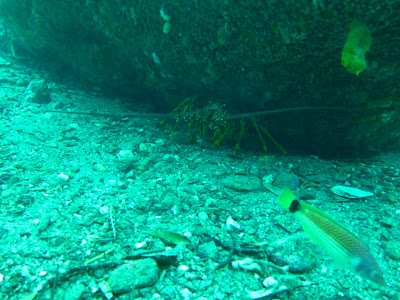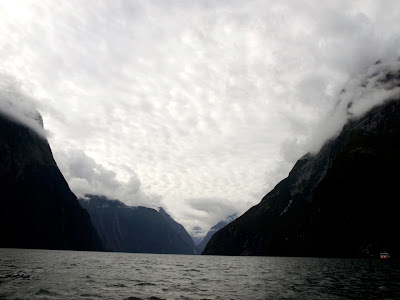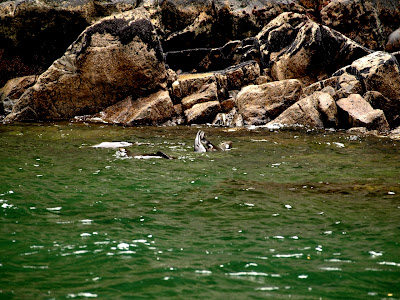Few sights are as stunning on this planet as fjords, those oceanic tongues that seem to have carved their way inland through steep mountains who rise high above sea level. In reality fjords are flooded canyons that were originally carved by advancing glaciers millions of years ago, but the geological reality of it isn't usually the first thing that pops into your mind when you're standing at sea level gazing up those cliffs in search of the sky.
When people hear the word fjord, the first place that usually pops into their mind is Norway. That used to be the case for me too. But now when I hear fjord, I'm transported back to New Zealand and its many natural wonders... starting with the fjords in Fiordland National Park (a World Heritage Site) along the south-west coast of the South Island. Images of Piopiotahi (a.k.a. Milford Sound) pop into my mind: mountains reaching towards the clouds with their feet dangling in sparkling waters, a penguin hopping along a rock, fur seals basking on the rocks and playing in the water, waterfalls that seem to be falling from the sky, and a completely alien world under the water's surface.
Milford Sound, home of the Piopiotahi Marine Reserve, is one of New Zealand's top tourist destinations, in spite of the distance to just about anywhere else, and the difficulty involved in getting there (although there are more isolated places in Fjordland). From the nearest town (Te Anau) it's a couple of hours along a narrow two-lane road with some windy climbs (and descents) through some very impressive mountains.
I was lucky enough to be able to make two trips into the Sound when in the region last January, which allowed me to view it under two very different skies,
 | |
| admiring Mitre Peak, one of the tallest mountains to rise directly out of the sea |
Jan 9, 2011. 4 PM. Breeze rustling the rushes, pushing the water up onto a pebbly beach. It's a beautiful place to just sit and take in the majestic beauty of Milford Sound. Even better, slipping my shoes off and stepping lightly into the water, hesitant of that first initial cold contact, only to discover that it's delightfully warm! And the spongy plants just beneath the surface are such a delight to walk on! Standing on a soft green cushion, waves rippling around my feet, wind in my hair... life is good.
It's amazing what a difference a bit of sun makes!
These isolated regions are perfect for a wide variety of animals: protected from the rough Tasman Sea waiting outside the sound, isolated from most predators, lush vegetation and freshwater in abundance, rich ocean waters with plenty of food... Of the many critters I met in Piopiotahi, I'm only going mention two here. Both spend part of their life on land, and part in the sea. Both are members of the "charismatic megafauna" which means the moment you see their photos you'll have the same reaction I did when I saw them: "ohhh!!! CUTE!!!" (I know a Uni professor who would kill me for using the C-word there, lol!) ;o)
Ready to meet them?
The first was what I call a lottery win: there's no way I should have seen it! A very rare species (endangered), plus the local population should have all been out to sea at that time of the year... so I have no idea what this little fella was doing hopping around on the rocks by the harbour, right underneath my nose!
Well, at times he was taking a bath...
and then he'd just hop back onto the rocks and keep waddling and hopping around, completely ignoring me (and my big zoom lens).
I give you Tawaki, the Fiordland Crested Penguin (Eudyptes pachyrhynchus)!
He (or she?) was about half a meter high. After talking about him to the park rangers we figured he was perhaps an adolescent who hadn't finished moulting (changing young duvet for adult feathers) in time to leave out to sea with the others. I hope he managed to survive on his own...
My second critter-encounter was of the mammalian variety, quite a bit more blubbery, and not as close up (since I was on a boat):
Kekeno, the New Zealand Fur Seals (Arctocephalus forsteri)!
It was so much fun watching these guys (all females or adolescents) playing in the water,
goofing off on the rocks,
and scaling that boulder!
I hoped one of them would come join us on our dive (not far from their rocks), but they were enjoying the sun too much I guess...
What do you say we dive down and see what there is beneath the surface in Milford Sound? After all, today is World Oceans Day, so let's get wet! ;o)
Let's hop in our dive boat and leave the harbour behind...
Make sure everyone's wrapped up in a warm 7mm wetsuit because the water is going to be COLD!!!
And of course, don't forget to choose a good DiveMaster or the experience won't be as good!
 |
| Alex, our fabulous Egyptian DiveMaster from Tawaki Dive |
Since it takes a while to get to the dive sites, just relax (be grateful it's not raining!) and enjoy the scenery:
There are waterfalls EVERYWHERE!!! Never in my life have I seen so many in one place! Water falling from the mountain-tops into the sea... that's because this is rainiest place in New Zealand! There's lots of snow on the tops of those mountains, and as it melts gravity dictates it has to go DOWN:
Well, all that freshwater (rain and waterfalls) explains the luscious vegetation we see all around us!
But that freshwater has quite a different effect on the Milford Sound aquatic ecosystem! You know how salt water is denser than freshwater and so if the two are together the salt water sinks? Yeah well... welcome to the world backwards! In Milford Sound there is so much freshwater (a non-stop supply thanks to the run-off from those cloud-covered mountains), that the surface waters of the Sound are actually freshwater (varying from 5 cm to 10 m depending on the precipitation), and the salt water is beneath this sweeter layer!!! Crazily enough, this also means that the surface water layer is MUCH colder than the bottom waters (which as any diver worth his salt will tell you: backwards!) because they're partially from glacial melting!!! So to go diving in Milford Sound, you need to be mentally prepared for the shock of jumping into water that is barely above freezing... before you get to the "warmer" waters below (which were still only 14ºC, so damn COLD in my book!).
Check this out:
See how dark that surface water is? That's also the fault of that freshwater layer. All that water that comes rushing down the mountains washes the tannins out of plants and the ground and carries them into the fiord. These tannins stain the surface waters and reduce the amount of light that can make it through to the area below the freshwater layer. Since life in the sea is pretty dependant on light... this means that although the fjords can be as deep as 400 m, life pretty much peters out after 40 m depth! A vast, dark desert lies beneath, as you can see in the adjacent diagram by the New Zealand Department of Conservation.
On the plus side, that also means that plants and animals that would usually be found at depths a diver wouldn't usually be able to reach, are now accessible! That means: Black Coral!!! This deep-sea tree-like coral can only be found near the ocean's surface in Milford Sound, thanks to that dark freshwater layer! The fjords in Fiordland National Park are home to the world’s largest populations of black coral trees (about 7 million colonies), with some of them up to 200 years old! Don't you dare break a piece off!!! >:(
Ok, enough talking... I'm going to let the pictures replace my words for a while.
Is that a sigh of relief I hear?! ;o)
The underwater pictures aren't mine, they were taken by one of my dive buddies on that trip who was kind enough to send me a selection afterwards. I've edited a few of them to include here :o)Our first dive was at Penguin Cove.
It only lasted 27' and we only went down to 17 m depth. The surface freshwater layer was a freezing 8ºC, and under that it "warmed up" to 14ºC (I'm still shivering just remembering it!)
After the initial shock of cold water and then crossing that dark layer I finally relaxed enough to admire my surroundings...
 |
| Black Coral Tree, Antipathes fiordensis |
Notice that crystal-like white tree? That's BLACK coral! The internal skeleton of the coral is black, and since that's what's found washed up on beaches... therein lies its name. Tricky!
 |
| Crayfish (or rock lobster) Jesus edwardsii and a female Scarlet Wrasse Pseudolabrus miles |
 |
| Jock Stewart Helicolenus percoides |
 |
| more black coral covered by sponges and algae |
 |
| Biscuit Seastar Pentagonaster puichellus on rock wall |
I could have spent much longer down there if not for the cold, and the fact that we had to be extra careful with our dive times for safety reasons (will explain later).
For safety reasons it's a good idea to spend a short interval at the surface before doing another dive, so we got to admire the cloud-scraping cliffs surrounding us, peek out of the sound and into the Tasman Sea,
 |
| looking out of Milford Sound into the Tasman Sea |
and of course admire those playful seals I mentioned earlier! ;o)
In fact our second dive site was called Seal Rock East... although the name was just as disappointing as that of Penguin Cove as neither penguins nor seals deigned to join our underwater frolics in either dive! :p
This dive lasted 26' and we only went down to 16 m depth. I had a harder time dealing with the cold than during the first dive... but was still awe-struck by my surroundings! We dove down along a sheer wall, if we hadn't been carefully monitoring our depth we could have reached 200 m (not good).
We also saw more black coral trees, but also plenty of other funky critters:
 |
| Brittlestar Ophiopsammus maculatus |
 |
| Spotty Notolabrys celidotus (I think) and solitary Ascidians Cnemidocarpa bicornuta |
 |
| Featherstar Oxycomanthus plectrophorum |
 |
| Cusion Seastar Patiriella regularis |
Brrrr!!! You cold yet? I am!!! Let's grab a cup of hot soup and figure out how we're going to spend the next 4h before we can head back home... Why 4h? Safety first in diving!!! You're not supposed to climb above certain altitudes x hours after diving, and to get out of Milford we were going to have to go up to 1000 m above sea level, twice! Fortunately our guide had a wonderful "time-wasting" plan:
We went to land!!! This is something the people who go on the regular cruises around Milford Sound don't get to do: walk at the base of those cliffs and wander around through the brush.
Although I must say I felt really odd doing that in a wetsuit! :p
And here's the reason why we had kept our wetsuits on:
Time for a (freezing) freshwater shower!!! :D
Ahhhh... now if only we had Hawai'ian temperatures... this would make a great shampoo ad! :p
After playing around on land, it's back to the boat, admire more waterfalls,
and head home (with much nicer skies than when we started out).
My! That was long... oops! I just got carried away with my story... it's such a magical place I couldn't leave anything out. I hope you enjoyed it! ;o)
This is my contribution to the Oceanic Blog-A-Thon and the Tiki Hut Beach Party for World Oceans Day. Go check out those blogging festivals for more interesting posts about our oceans! HAPPY WORLD OCEANS DAY!

Oh, and if you want a little extra, here's a Milford Sound diving video I found on YouTube:
And the video footage I took of the Fiordland Crested Penguin (I didn't have the energy to edit after writing this post):
Some of the info (and the two diagrams) were obtained from the New Zealand DOC website:
http://www.doc.govt.nz/conservation/marine-and-coastal/marine-protected-areas/marine-reserves-a-z/fiordlands-marine-reserves/facts/the-40m-band/


































Aw those penguins are gorgeous!
ReplyDeleteWhat a wonderful post! I have enjoyed reading it and look forward to checking out more of your blog!
ReplyDeleteHappy World Oceans Day to you!
-Shelley
Loved, loved, loved this post! You get to do the coolest things and you take such amazing pictures. I always learn such interesting things when I visit. Have a fun day!
ReplyDeleteOh Cris, what a wonderful day and such a gorgeous area! I would love to know how to dive and be below water with such amazing sea life!
ReplyDeleteThat crested penguin is such a cutie and I'm with you, I hope he/she was able to survive. Each life is so precious and they have so much to endure, it is up to each of us to make sure we do nothing that makes that even more difficult.
For some reason your video of the penguin is not showing up, but I enjoyed seeing an area of the world I've never known about.
Happy World Oceans Day!
Glad you guys enjoyed it! Was a delight to revisit that part of my trip... and made me wish I could go back! :D
ReplyDeleteGorgeous photos. I haven't been to NZ but will go there one day. :)
ReplyDeleteI can't recommend it highly enough Vee! I've been twice (once for 3 weeks, once for 4) and would go back in a heartbeat!!! I love it! And I don't think my sister (who has been living there for 5 years now) has any wish to leave the country either... ;o)
ReplyDeleteThanks so much for stopping by and visiting! Even more so for following! :o)
Fantastic post and beautiful pictures. Thank you for sharing!
ReplyDeleteRIW, glad you enjoyed it! :o)
ReplyDelete